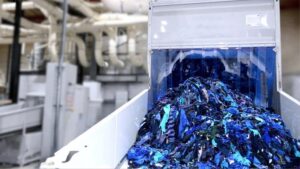The instability of the fashion supply chain in recent years will not be resolved in 2024, but will continue, as per McKinsey & Company’s latest report. Upstream apparel suppliers and manufacturers have experienced major disruption as changes in consumer demand have recently led to sharp declines in factory utilisation, large-scale layoffs and investment delays. As brands and retailers look to increase production capacity to meet growing demand, they may begin to feel the effects of recent upstream strains.
This turmoil, named as the ‘bullwhip effect’, amplifies even small shifts in consumer appetite. Picture a whip: a small movement at one end creates a thunderous impact at the other! In fashion, demand fluctuations ripple through the chain, growing wilder with each link. Retailers react to dips by slashing orders, manufacturers hit the brakes on production and textile mills nervously tighten their belts. Often, these decisions are fuelled by miscommunication and faulty forecasts, further amplifying the swings.
This phenomenon was particularly evident during 2020 and 2021 due to the pandemic. Delays in product arrivals led to an overcompensation by retailers, resulting in an excess of unsold inventory when economic uncertainty and inflation hit in 2022.
The fashion slowdown’s whip first cracked upstream. Fabric exports from the world’s top seven textile producers plunged nearly 20 per cent in late 2022 compared to the previous year, followed by 40 per cent plummet in yarn exports by the first quarter of 2023. Factories humming at full tilt in 2021 were limping along at 30 per cent – 40 per cent below capacity by 2023, as per experts. The pain spread even to machinery makers. Swiss giant Rieter, a bellwether for spinning technology, saw orders nosedive to 63 per cent in the first half of 2023, a stark reflection of the waning demand for textile machines.
This supply-chain volatility is not expected to subside in the near term. A McKinsey survey of chief procurement officers (CPOs) in September 2023 found that 73 percent believe demand volatility will be one of the top challenges affecting supplier relationships over the next five years. However, the third quarter of 2024 is the earliest that textile factories might see some capacity improvement. But even then, the consequences of the bullwhip effect may continue to linger. Layoffs and delayed investments may mean the industry is insufficiently prepared to scale up capacity quickly.
Many companies are rethinking their supply chains to de-risk manufacturing. According to McKinsey’s CPO survey, 54 percent of executives expect to increase reshoring or nearshoring in 2024. Others are thinking about rebalancing their sourcing footprint by sourcing from multiple countries. However, these approaches are not without challenges. Finding and contracting new suppliers, or partnering more closely with existing strategic ones, can be costly. Companies can also run into manufacturing limitations compared to traditional sourcing hubs or face new regulatory and compliance factors.
With sustainability regulations coming into effect in the EU and elsewhere that mandate companies to disclose environmental impacts on their supply chains and the push from investors to companies to disclose data about ‘scope 3 emissions’ (emissions arising as a result of the company’s activities, but originating from sources that the company neither owns nor controls), the risk may only increase for brands and retailers.
The whiplash of demand won’t disappear overnight; brands should prioritise fortifying their supply chains. First, emphasis should be given to transparency and collaboration. Tear down those silos and open up the communication channels. 70 per cent of procurement executives agree that sharing demand data with suppliers through clear systems and processes is vital to navigating turbulent markets. Joint forecasting, open discussions and shared insights will create a web of trust and agility that can withstand any bullwhip effect.
Secondly, brands must build a squad of partners and collaborators that runs deep. Cultivate strategic relationships with not only your direct suppliers, but also with those Tier-2, Tier-3 and Tier-4 partners who are essential to your business. Think long-term contracts, joint innovation projects and even co-investments in infrastructure to create a network that can bend and bounce back, not break under pressure.
| ‘Consumer tastes are becoming more difficult to predict’
Amidst the uncertain environment, we sought perspectives from Gunish Jain, CEO of BlueKaktus, a fashion technology company specialising in empowering fashion manufacturing, sourcing and retailing companies to improve lead times, cut costs and enhance overall performance through technological solutions. We inquired about the way forward. AR: Do you think supply chain volatility will linger in 2024 and beyond? GJ: Supply chain volatility will persist, given the uncertain geo-political environment. The Ukraine-Russia conflict continues to put pressure on the global supply chain and with the ongoing Israel-Hamas war and potential China-Taiwan flare up – the world will continue to see an uncertain environment which could lead to supply chain disruptions. Apart from this, technological changes and e-commerce will continue to disrupt the fashion supply chain. Consumer tastes are also becoming more difficult to predict. AR: What measures is your organisation taking to fortify supply chains against demand volatility, considering the emphasis on transparency and collaboration with suppliers? GJ: As a technology provider, we are working with brands/retailers in enabling their supply chain to become nimble and agile. By digitally connecting the supply chain, we are enabling a ‘mind-to-market’ of less than 30 days. This helps brands/retailers keep lower levels of inventory and conduct demand-based planning, rather than forecast-based planning. In addition to this, with global warming and increasing concerns on sustainability such as carbon emissions and water, traceability in the supply chain has become extremely important. We are also implementing digital tools on the supplier side so that they have real-time information that can be seamlessly exchanged and leveraged for quick decision making. The BlueKaktus platform connects manufacturers, fabric mills, yarn mills and trims suppliers bringing them on a single platform. This enables them to have a single view of things and collaborate effectively. AR: Considering the shift towards reshoring or nearshoring amongst many companies, what are the key considerations and challenges your organisation faces in altering or diversifying its sourcing footprint? GJ: While nearshoring is a trend, we believe this is not something which will fundamentally alter the global supply chain. Large brands and retailers would continue to work with the cost-efficient factories spread across Asia. By leveraging technology, we are enabling our customers to get quick reaction, nimbleness and predictability that they will get from a nearshore factory and yet avail the cost benefits of sourcing goods from lower cost countries. |








